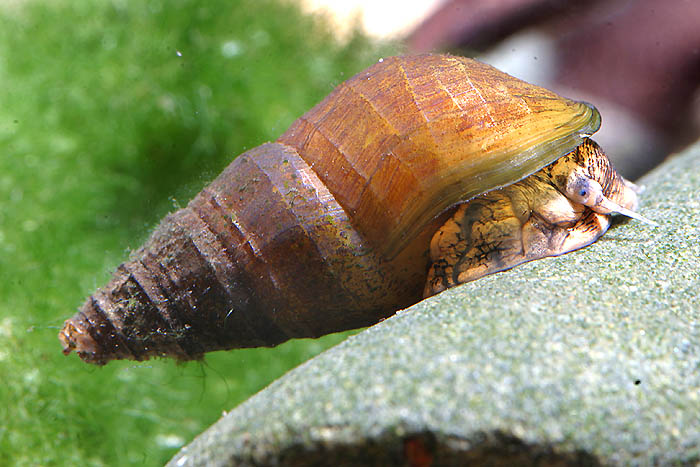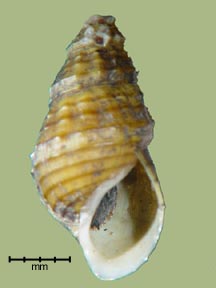Goniobasis or Elimia catenaria, albanyensis, athearni, boykiniana, etc.
> Habitat & Distribution
Populations bearing the typical shell form of P. catenaria inhabit rivers and streams of the piedmont and upper coastal plain from southern Virginia (Hoffman 1996) through the Carolinas into the Gulf drainages of Georgia and north Florida (Dillon & Robinson 2011). Trans-Appalachian populations are found in the Hiwassee drainage of Tennessee and western North Carolina (Dillon & Robinson 2009).
Pleurocera catenaria catenaria does not inhabit acidic or in nutrient-poor waters, and seems to require at least some rock substrate. Thus it is not found in high mountain creeks, nor in slow coastal plain rivers, nor in the (many) southeastern streams with high sediment loads. Its present spotty distribution (especially in South Carolina) may be a remnant of a much broader distribution prior to agriculture (Dillon & Keferl 2000). Its FWGNA incidence rank, calculated together with the sandy-habitat subspecies P. catenaria dislocata, is I-5.
> Ecology & Life History
Like other pleurocerids, P. catenaria is dioecious, eggs being deposited on hard substrates from spring to mid-summer. Eggs are spirally arranged in masses of 2-15 or more, with a tough, membranous outer covering to which sand grains typically adhere (Smith 1980, Jokinen 1992). Although we are unaware of any study specifically directed toward the life history of P. catenaria, it seems reasonable to expect that two years will be required for maturity, and that several years of iteroparous reproduction can be expected thereafter, as is the case for pleurocerids generally (Dazo 1965). This is life cycle Hi of Dillon (2000: 156 - 162).
The Georgia Goniobasis or "Oxytrema" populations studied by Nelson & Scott (1962), Krieger & Burbanck (1976), and Krieger (1977) are all referable to P. catenaria (see below) and all seem restricted to scattered rocky shoals isolated by long stretches of inhospitable silt. Where they reach high densities, however, grazing by pleurocerid populations can have a significant effect on energy flow in streams (Dillon 2000: 86 - 91).
> Taxonomy & Systematics
The type locality of P. catenaria ( St. Johns, Berkeley ) must have been Eutaw Springs, SC, sadly now drowned by Lake Marion. The viable P. catenaria catenaria population nearest Eutaw Springs today inhabits Cedar Creek, a tributary of the Broad River about 12 km N of Columbia. Dillon & Reed (2002) reported that the level of genetic divergence between the Columbia population and eight other P. catenaria populations sampled from North Carolina into Georgia was roughly comparable to the better-studied P. proxima. Dillon & Robinson (2009) included P. catenaria among the snails the dinosaurs saw. See my essay of 16Mar09 from the link below for more.
Mihalcik & Thompson (2002) hypothesized that the range of P. catenaria is attenuated south of the South Carolina border, and that Georgia streams might be inhabited by a great variety of other Pleurocera species, largely endemic, not distinguishable to our eyes from P. catenaria. The allozyme and mtDNA surveys of Dillon & Robinson (2009, 2011) demonstrated, however, that the range of P. catenaria does indeed extend across Georgia, to include all major Atlantic drainages as well as the Chattahoochee/Flint and Alabama/Coosa of the Gulf, extending even to the Hiwassee drainage of the Tennessee River.
See my essays of 15Feb17 and 14Mar17 from the links below for a review of pleurocerid taxonomy in Georgia and Florida. According to Chambers (1990) and Dillon & Robinson (2011), junior synonyms of P. catenaria (Say 1822) include albanyensis (Lea 1864), athearni (Clench & Turner 1956), boykiniana (Lea 1840), caelatura (Conrad 1849), christyi (Lea 1862), darwini (Mihalchik & Thompson 2002), interrupta (Haldeman 1840), lecontiana (Lea 1841), mutabilis (Lea 1862), postelli (Lea 1858), suturalis (Haldeman 1840), and viennaensis (Lea 1862). In 1840 Isaac Lea described another "Melania catenaria," which he renamed "catenoides" in 1842, which is a junior synonym of Say's (1822) catenaria as well. We follow Goodrich (1942) in preserving dislocata (Ravenel 1834) as an Atlantic drainage subspecies (Essay 4Feb14).
This species has travelled through three genera in thirty years. Although predominantly assigned to Goniobasis through most of the 20th century, in the 1980s many workers began placing it in the resurrected generic nomen, "Elimia." Both Goniobasis and Elimia were subsumed under Pleurocera by Dillon (2011). See my essay of 23Mar11 from the link below for more.
> Maps and Supplementary Resources
- Pleurocera catenaria distribution in Atlantic drainages (2023)
- Pleurocera distribution in Georgia and the Florida panhandle (2025)
- Distribution in the Tennessee/Cumberland (2022)
- Pretty photo of living P. catenaria catenaria, courtesy of Chris Lukhaup.

> Essays
- Taxonomic controversy has surrounded the generic nomina Pleurocera, Goniobasis, and Elimia for many years. The best entry into the subject would be my essay of 23Mar11, entitled Goodbye Goniobasis, Farewell Elimia. Links are available from that essay to older resources.
- See my FWGNA post of 16Mar09, The Snails The Dinosaurs Saw, for more on the genetics, taxonomy, and distribution of P. catenaria.
- The biological relationship between Pleurocera catenaria catenaria and P. catenaria dislocata served as the primary example in my essay of 4Feb14, What Is a Subspecies? That post also featured a figure comparing three shells from a Tar River population where the subspecies distinctions intergrade.
- I reviewed the tortured taxonomic history of P. catenaria in a pair of companion pieces, "Fred Thompson, Steve Chambers, and the Pleurocerids of Florida" (15Feb17) and "Fred Thompson, Elizabeth Mihalcik, and the Pleurocerids of Georgia" (14Mar17).
> References
Dazo, B. C. 1965. The morphology and natural history of Pleurocera acuta and Goniobasis livescens (Gastropoda: Cerithiacea: Pleuroceridae). Malacologia 3: 1 - 80.
Dillon, R. T., Jr. (2000) The Ecology of Freshwater Molluscs. Cambridge, Cambridge University Press. 509 pp.
Dillon, R. T., Jr. (2011) Robust shell phenotype is a local response to stream size in the genus Pleurocera (Rafinesque, 1818). Malacologia 53: 265-277. [pdf]
Dillon, R. T., Jr. & Keferl, E. (2000) A survey of the pleurocerid gastropods of South Carolina. In Freshwater Mollusk Symposia Proceedings, Part II, eds. Tankersley, Warmolts, Watters, Armitage, Johnson & Butler, pp. 153 - 160. Columbus: Ohio Biological Survey.
Dillon, R. T., Jr. & Reed, A. (2002) A survey of genetic variation at allozyme loci among Goniobasis populations inhabiting Atlantic drainages of the Carolinas. Malacologia 44: 23 - 31. [pdf]
Dillon, R.T., Jr. & Robinson, J.D (2009) The snails the dinosaurs saw: Are the pleurocerid populations of the Older Appalachians a relict of the Paleozoic Era? J. N. Am. Benthol. Soc. 28: 1-11. [pdf]
Dillon, R. T., Jr. & Robinson, J. D. (2011) The opposite of speciation: Genetic relationships among the populations of Pleurocera (Gastropoda: Pleuroceridae) in central Georgia. Am. Malac. Bull. 29: 1 - 10. [pdf]
Goodrich, C. (1942) The Pleuroceridae of the Atlantic coastal plain. Occas. Pprs. Mus. Zool. Univ. Mich., 456, 1-6.
Hoffman, R. L. (1996) Occurrence of the costate riversnail, Oxytrema catenaria (Say), in Virginia. Banisteria, 7: 49-50.
Jokinen, E.H. 1992. The Freshwater Snails (Mollusca: Gastropoda) of New York State. NY State Mus Bull 482, Albany, New York.
Krieger, K. (1977) Morphological and electrophoretic evidence of population relationships in stream snails of the family Pleuroceridae (Prosobranchia). Ph.D. Diss, Atlanta, Ga., Emory University.
Krieger, K. & W. Burbanck (1976) Distribution and dispersal mechanisms of Oxytrema (=Goniobasis) suturalis Hald. (Gastropoda:Pleuroceridae) in the Yellow River, Georgia, U.S.A. Am. Midl. Natur., 95: 49-63.
Mihalcik, E. R. & F. G. Thompson (2002) A taxonomic revision of the freshwater snails referred to as Elimia curvicostata, and related species. Walkerana 13: 1 - 108.
Nelson, D., & D. Scott. (1962) Role of detritus in the productivity of a rock-outcrop community in a piedmont stream. Limnol. & Oceanog., 7: 396-413.
Smith, D.G. 1980. Goniobasis virginica Gastropoda Pleuroceridae in the Connecticut River USA. Nautilus 94:50-54.
Thompson, F. G. (2000) Freshwater snails of the genus Elimia from the Coosa River System, Alabama. Walkerana 11(25): 1 54.








